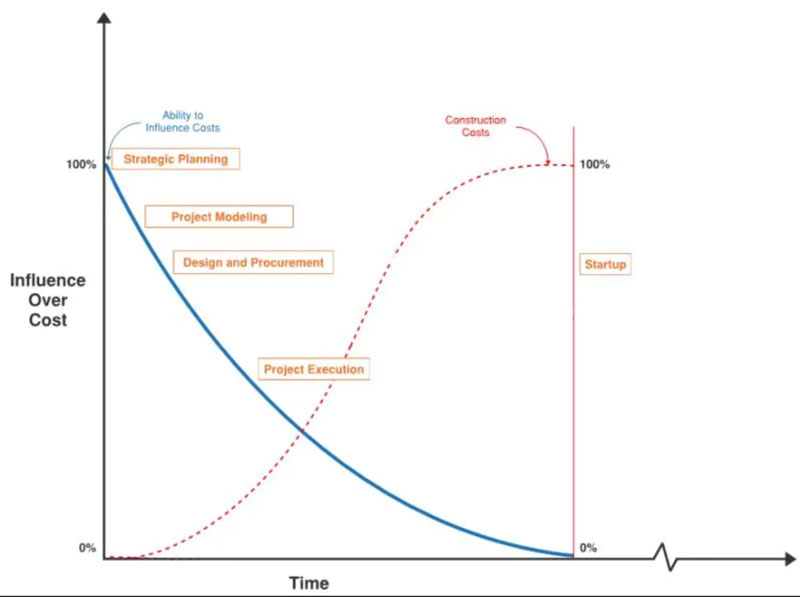
There is a deceptive time between a project’s conception and actual start when a project “hasn’t really started” …right? This is one of the risky times in the life of a project because there is a perception that the project clock has not started, a feeling that you’re playing with house money. However, the truth is that much of the conditions that a project plan must incorporate are a result of decisions, or lack of decisions, that are made during the internal planning period. See figure above for illustration.
There is a time when project conception evolves into a project “on the clock”, often during a period of compelled indecision due to lagging financing, property closure, product contracts, etc. tht are unresolved. Although this may feel like a neutral start period, the project plan is actually evolving. Too often we think that, as soon as roadblocks are cleared, it is time to release the hounds and go a fast a possible into construction. This leaves a gap in the necessary strategic planning where owner’s expectations, options, and cost can be preserved and managed. The absence of this purposeful and strategic planning results in an inherited set of fixed parameters that at best will skew the expectations and options, and at worst will cause budget and time to be driven by ghosted conditions embedded into the project.
The life cycle of real project planning is a science, not an art. Planning for a project begins at conception, not when there are financial commitments of vendor contracts to procure. Project strategic planning is a result of real-world experience and a proven process where an intentional steering occurs based on the expectations of the sponsoring enterprise, as well as preserving a list of priorities that many owners fail to recognize until they have passed. Many owners do not always know what these priorities are before construction, but always recognize what they do not or did not want, after the fact.
Strategic planning is not something that a vendor can throw in to make the deal. If there was ever a true rendition of “you get what you pay for”, it is with real project planning. Objective planning from a subjective source is the most expensive “free service” you will ever dearly pay for. True strategic planning is, by its nature, a source of ROI by instituting objective competent processes and knowledge-base project commitments that are elective rather than compulsory. Unfortunately, some of our best clients have learned by bad experience that when project planning is the result of compulsory actions, followed by full-throttle construction starts, it is a costly and frustrating experience.
We begin an established process of analysis as soon as the project conception requires any action steps, followed by an even more detailed modeling process. This assures that expectations and options are firmly laced into the project delivery. Project delivery is always a bi-product of the actual planning that was executed prior. This means the intentional steps, as well as the unintentional or missing actions taken, all make up the elements available for the project delivery. Much like packing for an exotic trip to a remote destination, what you pack or don’t pack is what you live with on the trip. Purchasing added supplies or equipment that was not planned is a very expensive often an impractical option resulting in dissatisfying compromises and paying high prices for things that were not really needed or wanted.
When taking this kind of trip, it is always best practice to seek out an objective guide who has been to this destination that can understand what your ultimate goals are and help you plan accordingly. Conversely, if you were to rely solely on an outfitter that can sell you anything you need at the destination, you may find that the planning is biased more to the outfitter’s agenda than your own, including very high prices and limited availability. Although the outfitters advise may be free before the trip, it will cost much more during the trip. The guide service’s entire reputation rests on the experience you have as a result of proper planning and expectations met, rather than exploitation of a captured customer with very few options and demanding needs to complete the trip. The guide service must offer competent objectivity to eliminate such conflicts of interest and assure not only a better outcome but also added savings, making the service not only no-cost, but also return on the investment.
“Ready, fire, aim” has plagued the building process for as long as I can remember in some form or another, often due to owners that yield to a process based on compulsory impulses. Wisdom does come at a dear price in the industry and many have paid to acquire the wisdom of planning averts cost and dissatisfying outcomes. However, too often each generation must learn the same lesson over. The worst explanation is that we do not have time to plan, this is a pure example of too busy chopping wood to sharpen the ax.
Planning does not always mean delaying the start. In fact, planning infused early enough will actually accelerate a project and more importantly accelerate with correct content.




